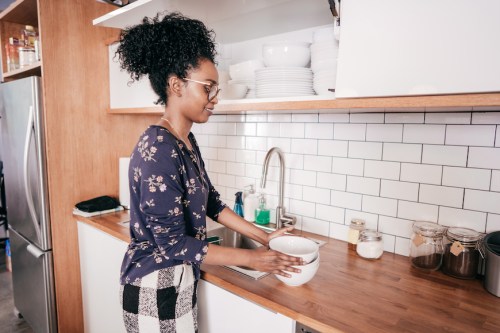Our editors independently select these products. Making a purchase through our links may earn Well+Good a commission
The Best Way To Organize the Kitchen, According to Someone Who Does It for a Living
An interior designer and expert organizer explains how to organize the kitchen, giving tips for everyting from cookware to pantry staples.

No one likes it when a houseguest, whether it’s an aunt or mother-in-law, comes into your kitchen and starts rearranging all the cabinets. You go and reach for a mug for your morning coffee only to find yourself staring at a stack of bowls. Or you open the junk drawer to grab some scissors and find that your silverware lives there now. Kitchen surprises should only come in the form of fluffy pancakes or matcha rice krispies treats.
Experts in This Article
interior designer and expert organizer
That said, Carly Waters, an interior designer and expert organizer, believes there is absolutely a “right” way to set up and organize the kitchen and it all comes down to one word: efficiency. While, yes, Waters definitely works with clients to make their kitchens chic, she also helps them set it up in a way that makes everyday cooking and living easier.
Here, Waters details the best way to set up the kitchen—no matter how big or small. The days of hunting around for your avocado slicer are over. And with any luck, you’ll also see the end of well-intentioned houseguests giving your space an unwelcome makeover.
How to set up and organize your kitchen, according to an expert
Cooking utensils and spices
When setting up a kitchen, Waters likes to start by the stove, where a lot of time is spent. “If you’re right handed, your cooking utensils—like your spatula, slotted spoons, and tongs—should go in the drawer to the right of the stove,” she says. “That way, you don’t have to walk across the kitchen to grab something you need right away when you’re cooking.” If you don’t have a drawer next to the stove, Waters says you can place your utensils in a utensil holder on either side of the stove, depending on whether you’re right- or left-handed.
On the other side of the stove (so to the left, if you’re right-handed and to the right, if you’re left-handed), Waters says you should place the kitchen tools that you still use, but not as regularly as, say, your spatula. “This includes things like your can opener, garlic press, [and] avocado slicer,” Waters says.
Your cooking utensils may all have a home, but don’t step away from the stove just yet. Waters also recommends putting your spices next to the stove. (Yep, she doesn’t keep them in the pantry.) “I always put my spices right by the stove because you use them so much when you’re prepping and cooking,” she says. “You don’t want to have to walk over to the pantry in the middle of cooking.” To keep it looking organized, you may want to invest in a countertop spice rack. If you’re the kind of person who has a lot of spices, keep the ones that you use most often (say, garlic powder, turmeric, salt and pepper, cumin…) near your stove top. The blends and other spices that you use less often can hang out in the pantry or in another spot out of the way until you truly need them.
Cookware and appliances
With the theme of efficiency in mind, Waters says you should also have your go-to cookware close to the stove for easy access. “I put the pots and pans to the right—if you’re right handed—and to the left are your saucers and sauce pans,” Waters says. (Follow the inverse if you’re left-handed.) Baking trays should also be near the stove in the next closest place you have to store them.
When it comes to cooking tools like your blender, air fryer, Instant Pot, and toaster, Waters recommends only keeping what you use every day on the counter to avoid clutter. For her, that means keeping the blender out and stashing the other kitchen appliances in a cabinet (whatever your biggest one in the kitchen is, since these babies tend to be bulky) hidden from sight.
Dishes and silverware
Next to cookware and appliances, dishes definitely tend to take up the most real estate in the kitchen. When it comes to where to put them, Waters says to simply think about what makes the most logical sense. Depending on the layout of your kitchen, that might mean putting the mugs directly above your coffee maker, for example, or glasses in a cabinet closest to the fridge. Waters encourages people to think about how they truly use your kitchen space and go from there. Are your bowls used primarily for oatmeal and cereal? Then perhaps it makes sense for them to be placed closer to the pantry, where those foods are placed.
Waters says there should also be a designated drawer or shelf for food storage containers. “I also recommend putting the lids on each one instead of stacking them so that the lids don’t get lost,” she says. Items like plastic wrap or tinfoil may also make sense to be kept near storage containers, since those items fall into the “leftovers” category.
Pantry and fridge
Speaking of the pantry, you can bet that Waters has some organizing tips for this part of the kitchen, too. “I’m a big fan of storing foods like rice, pasta, flour, nuts, and anything else you can in glass jars,” she says. “That way, you can take a picture of your pantry before you go to the grocery store and you immediately know what you need more of.”
Whether you have a walk-in pantry or just shelves, Waters recommends trying to have one shelf for baking ingredients, one shelf for breakfast foods (like cereal, oatmeal, and pancake mix), one shelf for foods like pasta and rice, one for snacks, and one for canned goods. Again, this depends on the space you have—you might have to combine sections or tailor-make your own based on how you eat. But having designated places for things, no matter how small, is key.
Waters applies the same organizational logic to the fridge, too. She recommends keeping condiments in the fridge door and then having a shelf for drinks, a crisper drawer for veggies, crisper drawer for fruit, designated area for dairy, designated area for meat or alternative proteins, and a space for leftovers. That way, you know where everything is. “Organizing your pantry and fridge like this cuts down on food waste because it prevents you from forgetting what you already have and buying double of something, or letting something go to waste that you forgot about,” she says.
Coffee and tea
A lot of people tend to acquire a lot of coffee and tea varieties, which can get messy real fast if you let it. By now, you can probably guess where Waters recommends these items be stored: Yep, right near the coffee maker. “Whenever possible, I like making functional items look really beautiful, so I actually store my tea in a plastic organizer I got from Ikea that was technically for the bathroom,” Waters says. “It looks so pretty that I love having it out on the counter.”
Trash bins and cleaning supplies
Over by the sink, Waters uses this part of the kitchen to put trash and recycle bins. It’s also where she recommends keeping dishtowels, if you have a drawer nearby. “In terms of cleaning supplies, the only ones I keep under the sink in the kitchen are ones that are specifically for the kitchen, like dish soap, detergent, and countertop spray,” she says. All other cleaning supplies she keeps in a closet outside of the kitchen, where items like mops and brooms are stored.
The biggest mistake Waters says she sees people make when setting up their kitchens is not giving everything a home. That’s when junk drawers start to multiply and cabinets start to get cluttered. With her tips in mind, not only does everything have a home, but it has a logical one.









